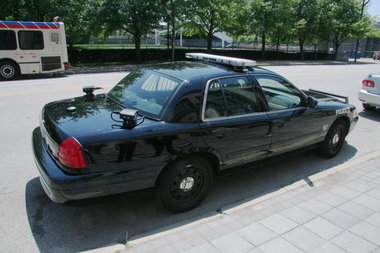 View full sizePatrol officers and deputies in five Northeast Ohio counties now have surveillance equipment that scans thousands of license plates per minute, alerting officers to plates linked to stolen vehicles, Amber alerts and felony warrants. There are 37 of the devices attached to patrol cars in Cuyahoga, Lake, Lorain, Geauga and Ashtabula counties. This photo was provided by the city of Cleveland.
View full sizePatrol officers and deputies in five Northeast Ohio counties now have surveillance equipment that scans thousands of license plates per minute, alerting officers to plates linked to stolen vehicles, Amber alerts and felony warrants. There are 37 of the devices attached to patrol cars in Cuyahoga, Lake, Lorain, Geauga and Ashtabula counties. This photo was provided by the city of Cleveland. JORDAN STEFFEN, Tribune Washington Bureau
WASHINGTON -- Just after midnight on Oct. 26, the stolen Jeep Cherokee of a university professor who was slain the previous morning passed a camera mounted on a pole. It took the automatic camera less than a second to scan and process the license plate number, discover it in a database and send out an alert to police cars.
A detective spotted the vehicle and chased it, leading to the arrest near downtown Washington of the 18-year-old driver, who is being held in nearby Montgomery County, Md., on auto theft charges and is considered "a person of interest" in the homicide, police said.
The technology used in this case has recently swept the country. Long used in Europe, it is now employed in all 50 states and is also helping to combat the flow of drugs, illegal currency and weapons across the U.S.-Mexico border.
U.S. Customs and Border Protection awarded a contract in October worth as much as $350 million to increase its use along the border, where thousands of license plates are processed by the system every day.
But the technique, which, unlike speed cameras, snaps pictures of all vehicles passing by, worries privacy advocates. Wary of its ability to pinpoint and store the location of vehicles, they worry that innocent people may become easy targets for tracking.
"It's like being forced to walk around with a bar code that a scanner can pick up -- except that it's your car," said Lee Tien, senior staff attorney for the Electronic Frontier Foundation in San Francisco, which advocates for consumer and privacy rights.
The relatively simple technology consists of cameras, either mounted on police cars or at a stationary location, capable of capturing and processing more than 100,000 license plate images an hour. Plate numbers are automatically run against "hot list" databases of stolen, suspicious or crime-related vehicles, said Capt. Kevin Reardon of the Arlington, Va., Police Department.
Before, officers who had the time manually entered plate numbers. The new technology processes every plate captured by the camera and alerts police when there is a hit from one of the hot lists.
"It's quick and efficient," Reardon said. "Officers can do their jobs better and catch more bad guys."
In Arlington, license plate readers lead to at least one arrest a day, Reardon said. There are 200 mobile cameras in the capital region, and a number of stationary cameras in Washington and Maryland.
One stationary system costs about $15,000 and a mobile system about $20,000, said Nate Maloney, vice president of marketing and communication at ELSAG North America, which manufactured the systems used in the capital. The basis of the technology, which can scan 1,800 plates a minute, was developed from the same optical character recognition systems used to read ZIP codes in sorting mail.
Customs and Border Protection started using it in 2009. Nearly 500 cameras were installed on inbound lanes at the 39 busiest land ports along borders with Canada and Mexico.
"What we really require to do our job more effectively is real-time, actionable information. To know who is a bad guy and who is not," said Colleen Manaher, an official in the agency's office of field operations.
As vehicles approach checkpoints, stationary cameras take images of the front and rear license plates, a driver image and a color picture of the car, said Christopher Milowic of the agency's office of information and technology. Those images are then run through a database.
Cameras can also read and process enhanced travel documents, Milowic said. Enhanced documents are embedded with radio frequencies and can be processed simply by holding them in the direction of the camera.
In October, Unisys Corp., which manufactured the hardware and software installed in 2009, received an additional contract from Customs and Border Protection worth as much as $350 million over the next five years. Under the contract, new systems will be installed at busy pedestrian crossings, and existing systems will be replaced with technology that is 15 percent more accurate.
But the same technology that makes it easier and faster to peg suspicious vehicles also makes it easier to track innocent people, said Tien, the Electronic Frontier Foundation lawyer.
Every time a scan runs through the system, the location of the vehicle and the date the image was taken are stored in a database -- even if it does not trigger an alert. Individual agencies determine how long that information is stored, Reardon said. Some agencies store the data for a couple of days, others for six months. Arlington clears its database once a month.
That much information in one place makes it easy to "connect the dots" and track where a vehicle has been, revealing whether it stopped "at the opera or a strip club," Tien said.
A number of concerns surrounding the technology could be eliminated by immediately erasing scans that do not trigger an alert, said Chris Calabrese, legislative counsel for the American Civil Liberties Union.
"You can always misuse a technology," Calabrese said. "But a widespread misuse is going to be pretty limited if you're not saving the records of innocent people."
------
(c) 2010, Tribune Co.
Distributed by McClatchy-Tribune Information Services.

